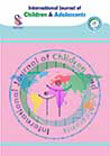فهرست مطالب

International Journal of Children and Adolescents
Volume:3 Issue: 2, May 2017
- تاریخ انتشار: 1396/03/30
- تعداد عناوین: 5
-
Pages 1-9Background And ObjectivesTo determine the association of hyper-reactivity to environmental allergens and mucosal secretion cytology with the course of disease in patients with chronic rhinosinusitis and nasal polyps (CRSwNP).MethodsA cross sectional study was conducted at Tehran Clinic of Asthma and Allergy in 2016. Adult patients who earned the definite diagnosis of CRSwNP and were free of serious underlying disease were selected.
A comprehensive history regarding the course of disease was taken. Success or failure of previous interventions was defined as subsiding the symptoms and no need for further invasive intervention of surgery. Physical examination, pulmonary function test, nasal smear from both nasal cavities and skin prick test were performed for all enrolled subjects. The results were compared among participants with different course of disease.ResultsA total of 45 patients with mean age of 35.8±11.7 (18 to 60 years) were enrolled. Of the participants, 30 (66.7%) had asthma, medical treatment was failed in 23(51.1%), 25 underwent surgery in whom it was failed in 5 (11.1%). Regardless of course of disease, neutrophilia was the predominant cytology of nasal smear. Of the participants, 17 (37.8%) had no sensitization, while, 11(24.4%) showed mono-sensitization and 17(37.8%) were poly-sensitized. Seasonal allergy was found in 16(35.5%), while, perennial sensitization was in 19 (42.2%). Failures of medical treatment were more sensitized to seasonal allergens (45.2% vs 14.3%, p=0.045). Failures of surgery, were found to have poly sensitization to both of perennial and seasonal allergens (66.7% vs 21.1%, p=0.037).ConclusionAtopy is frequently present in patients with CRSwNP and pattern of sensitization can affect the outcome of intervention. With respect to different pattern of sensitization among failed and successful interventions, determining the sensitizations prior to any intervention is suggested. Patient counseling regarding the recurrence of disease can be done in accordance with atopic profile.Keywords: Chronic rhinosinusitis, Allergy, Asthma, Atopy -
Pages 10-13Background And ObjectivesPerinatal asphyxia may cause severe damages in different organs such as kidneys, lungs, liver and most importantly CNS. The current study aimed to evaluate and compare the prevalence of liver impairment among asphyxiated and normal neonates.MethodsA retrospective case-control study was carried out in a referral pediatrics Hospital (Iran- from 2013 to 2015). Term and preterm asphyxiated neonates born in hospital were registered as the case group. Serial laboratory tests including CBC, Crateanin, BUN, Na, K, Ca and blood sugar were done. ALT, AST and ALP were also measured at day of third to fifth of life. Healthy neonates who admitted due to hyperbilirubinemia were also considered as the controls and their liver enzymes were checked at day of third to fifth of life. All participant's demographic data and laboratory findings were extracted from medical records. Liver impairment by assessing liver enzymes was compared between case and control groups. The level of significance was considered as pResultsForty-nine asphyxiated neonates as the case and 20 icteric neonates as the control group entered the study. Of all asphyxiated neonates, 23 cases (46.9%) showed seizure, 25 (52.1%) type II and 23 (47.9%) type III Hypoxic-ischemic encephalopathy. Seven (10.1%) asphyxiated neonates died. More neonates in control group had gestational age > 37 weeks (pConclusionElevated ALT and ALP in 3-5 days of age can be utilized as possible predictors of perinatal asphyxia.Keywords: Birth asphyxia, Neonate, Aspartate aminotransferase (AST), Alanine aminotransferase (ALT), Alkaline phosphatase (ALP)
-
Pages 14-19Background And ObjectivesAttention Deficit/Hyperactivity Disorder (ADHD) occurs concurrently with many psychiatric disorders. Considering lack of information about comorbid psychiatric disorders in Iranian children, this study was performed to evaluate the prevalence and pattern of psychiatric disorders comorbidity in the children with ADHD.MethodsIn a cross sectional study, frequency of comorbid psychiatric disorders in a randomly selected sample of children with definitive ADHD referred to child and adolescent psychiatry clinic of Kashan University of Medical Sciences, Iran, was determined through clinical interview using Kiddie's Schedule for Affective Disorders and Schizophrenia.ResultsThe mean age of participating children was 7.35±1.23 years and 132(66%) children were boy. Among 200 children, 107 (53.5%) had at least one comorbid psychiatric disorder which Obsessive-Compulsive Disorder was most prevalent psychiatric disorders following with Enuresis, and Oppositional Defiant Disorder respectively. There were statistically significant relationships between age and the type of comorbid psychiatric disorders.ConclusionConsidering the high prevalence of psychiatric disorders comorbidity such as OCD, Enuresis and ODD in children with ADHD, precise diagnosis and proper treatment is essential. More studies are recommended for detection and proper treatment of these psychiatric disorder comorbidities.Keywords: Attention Deficit Hyperactivity Disorder, Comorbidity, Psychiatric Disorder
-
Pages 24-29Background And ObjectivesStudents with learning difficulties encounter poorer school outcomes and major problems in learning. Researchers investigated the factors in preschool stage that will help to diagnosis learning problems.MethodsA meta-analytic review provides means for assessing which factors show the strongest effects on long-term outcomes.ResultsThis article presents a meta-analysis of main screening tests of learning disabilities examining 3 sources and 27 samples published from 2000 to 2017 in Iran. Fourteen screening tests were identified among 25 studies. The combined effect size for detection were 24.262 (CI: 19.111-29.412), respectively. Among them, the Kaufman's Neurological-Clinical Diagnostics Battery is the best alternative for preschoolers screening.ConclusionImplications for future research and practice are considered.Keywords: Learning readiness, Preschool children, Learning disabilities
-
Pages 33-35This case report is about a 28-day-old neonate that had abdominal distention and massive hepatomegaly since 15th days of birth. First, he was normal, and he had not any sign and symptom of sepsis. At admission, he was about twelve days, he had a rapid progressive presentation of sepsis and unfortunately, he passed away. His liver biopsies manifested the neuroblastoma.Keywords: Neuroblastoma, Neonatal malignancy, Abdominal distention

